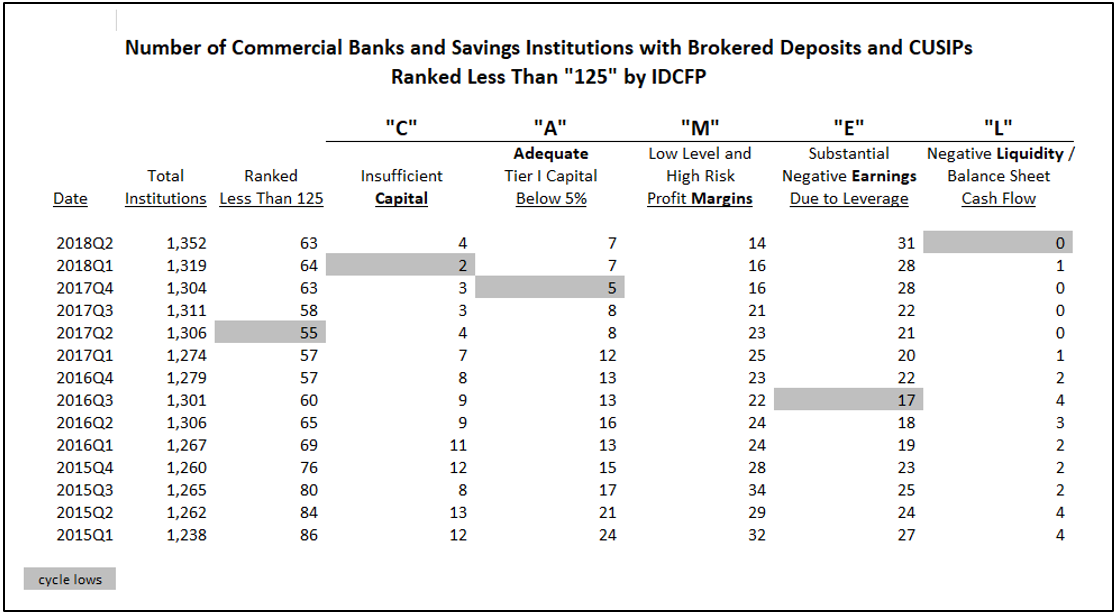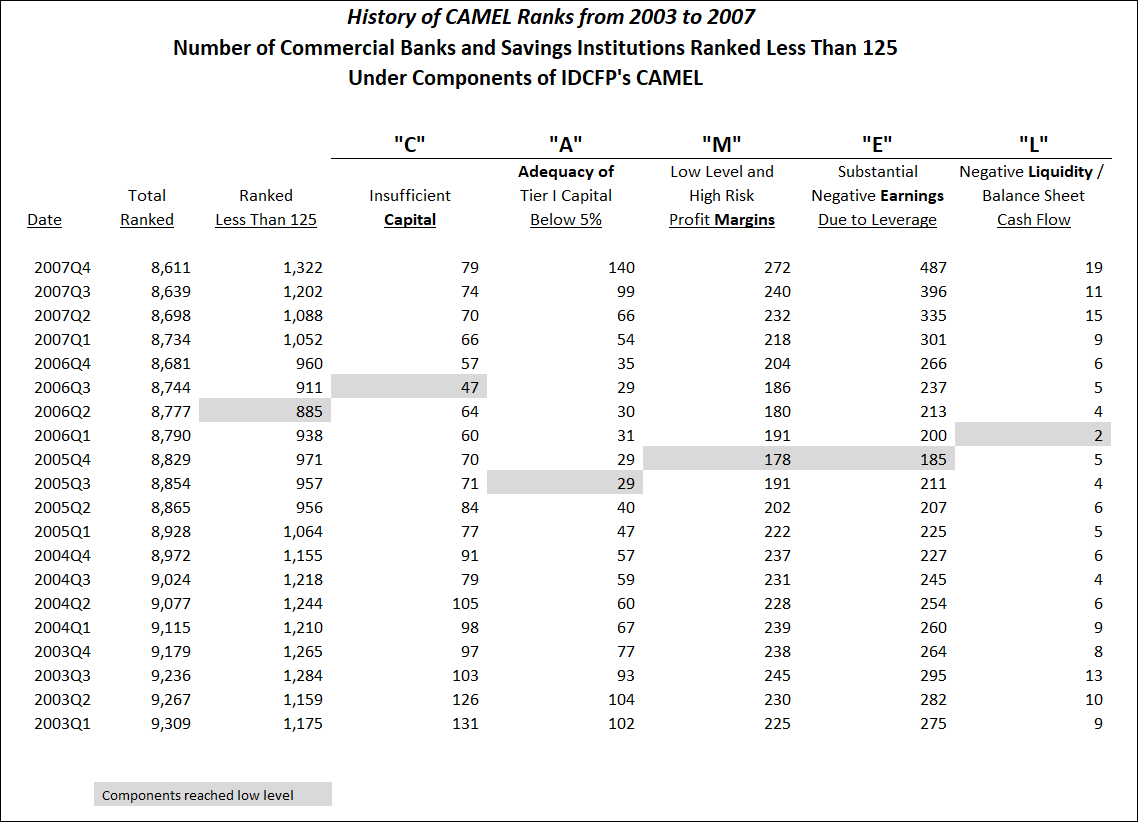IDCFP’s CAMEL Ranks Explained; The “E” in CAMEL: Earnings Returns
IDC Financial Publishing, Inc. (IDCFP) utilizes the acronym CAMEL to represent the financial ratios used to evaluate the safety and soundness of commercial banks, savings institutions and credit unions. This article explains how IDCFP uses earnings returns as a key component of its CAMEL ranking system, and why it is valuable and important to monitor.
Good management strives to increase return on equity (ROE) above cost of equity (COE). IDCFP calculates nominal COE by adding one-half of the 30-year T-Bond yield, plus 20% of the standard deviation of the operating profit margin for the S&P 500, to the 30-year T-Bond yield. A successful ratio of ROE to COE is demonstrated by the commensurate increase in price-to-book value.
Looking at an institution’s ROE in terms of return on operating earning assets (ROEA) and return on financial leverage (ROFL) provides additional insight into management’s style, financial and operating decisions.
- ROEA is defined as after-tax income from operations before funding costs (income from loans, investments and non-interest income, minus operating expenses, applicable taxes and the change in the loan loss reserve, as a percent of earning assets). This income reflects the operation of an institution, as if equity and loan loss reserves were total liabilities and capital.
- ROFL is defined as after-tax income from financial operations. It reflects the degree to which an institution uses deposits and debt to finance its operating strategy. ROFL consists of the leverage spread, which is return on earning assets (ROEA) minus cost of adjusted after-tax deposits and debt, times the leverage multiplier, which is the ratio of adjusted deposits and debt to equity and the loan loss reserve.
As the Federal Reserve raises the federal funds rate to 3% or more over the next year, rising costs of funding, combined with low levels of operating returns, could create continued losses in net income for firms with negative earnings (“E”), and potentially affect more financial institutions. Banks with low after-tax operating profit returns (ROEA), due to inefficiencies in operations, experience the same increase in funding costs as other banks.
A low return from operations, combined with rising funding costs, creates a negative leverage spread. This negative spread multiplied by a bank’s leverage provides a highly negative ROFL, leading to more banks ranked below 125 as a result. IDCFP’s ratings of banks, savings institutions, and credit unions range from 300 (the top grade attainable) to 1 (the lowest). From the early 1990’s, through today, institutions using our ranks determined that ratings lower than 125 were deemed below investment grade.
A Forecast for the Next Banking Crisis
Out of the 5,589 total commercial banks and savings institutions, IDCFP has identified 1,352 that have outstanding brokered deposits. Using this group of 1,352 institutions, and tracking institutions ranked less than 125 within this group, provides a forecast for the next era of banking problems in 2021.
Table I illustrates this trend when examining these commercial banks and savings institutions ranked less than 125 by IDCFP with our CAMEL analysis.
- The number of institutions reached a low of 55 in the second quarter of 2017.
- The “C” component, or institutions with insufficient Capital fell to a low of 2 in the first quarter of 2018 and increased in the second quarter.
- The “A” component represents institutions lacking Adequacy of capital to cover delinquency with less than 5% risk-adjusted capital. These institutions declined to a low of 5 in the fourth quarter of 2017.
- The “M” component, which uses Margins as a measure of management continues to decline, reaching a low level of 14 in the second quarter of 2018.
- The “E” component represents institutions exhibiting negative Earnings or returns on financial leverage (ROFL). These institutions fell to a low of 17 as early as the third quarter of 2016.
- Finally, the “L” component represents negative Liquidity, or high levels of loan delinquency with negative balance sheet cash flow. This fell to a floor of 0 in the second quarter of 2018.
When examining institutions with outstanding brokered deposits, there is an increase in the number among these ranked less than 125 by IDCFP. The current trend shows the number of these institutions in most components of CAMEL have hit a low and are rising (see Table I). This group of institutions ranked less than 125, and having brokered deposits, points to another potential banking problem in 2021. Similarly, in 2005 and 2006, IDCFP’s CAMEL ranks under 125 of all institutions forecast the 2008 and 2009 banking crisis. (See Table II).
Table I

Early Warning Indicators in History
The number of commercial banks and savings institutions ranked below 125 reached a low in the 2nd quarter of 2006, two years before the banking crisis in 2008. More importantly, leading up to this point, 4 out of the 5 components of CAMEL also reached lows from the 3rd quarter of 2005 through the 1st quarter of 2006, and then began to rise.
As seen in Table II below,
- Commercial banks and savings institutions with insufficient capital reached a low of 47 institutions in the 3rd quarter of 2006.
- Financial institutions with less than 5% adequacy of capital reached a low count of 29 in the 3rd quarter of 2005.
- Banks and savings institutions with a lack of profitability, or low and unstable margins, reached a low of 178 in the 4th quarter of 2005.
- The commercial banks and savings institutions with severe negative earnings due to financial leverage reached their low of 185 in the 4th quarter of 2005.
- Finally, institutions with high loan delinquency and negative balance sheet cash flow, or negative liquidity, reached their low of 2 in the 1st quarter of 2006.
All 5 categories of rank,Capital, Adequacy of capital, Margins as a measurement of management, Earnings from operations and financial leverage, and, finally, Liquidity,
together provide a timely indication of risk and potential failure. An increase in the number of banks ranked under 125 in all components of CAMEL is required to confidently forecast a future banking crisis.
Table II

As seen in history, the increase in the number of financial institutions with IDCFP’s CAMEL ranks below 125, or below investment grade, forecast the bank financial crisis a few years later. IDCFP’s ranks are critical for investors to monitor financial institutions.
To view our products and services please visit our website at www.idcfp.com . For further information about our CAMEL ranks, or for a copy of this article, please contact us at 800-525-5457 or info@idcfp.com.
John E Rickmeier, CFA, President, jer@idcfp.com
Robin Rickmeier, Marketing Director
